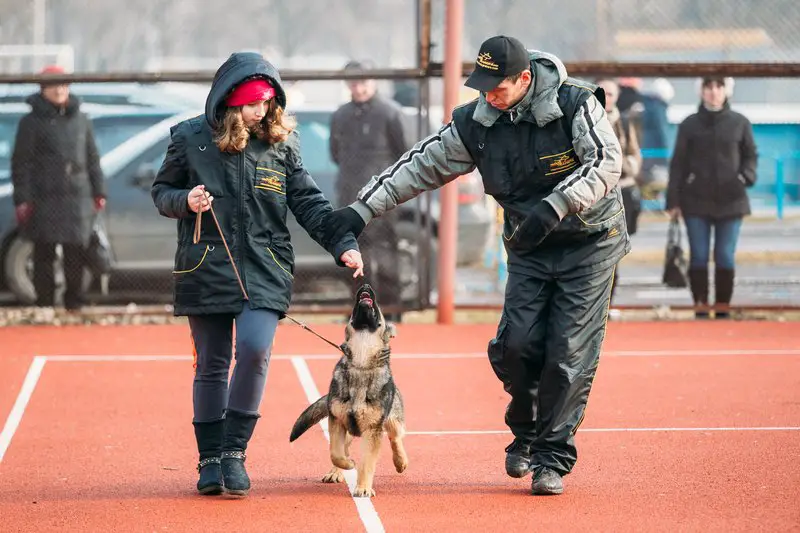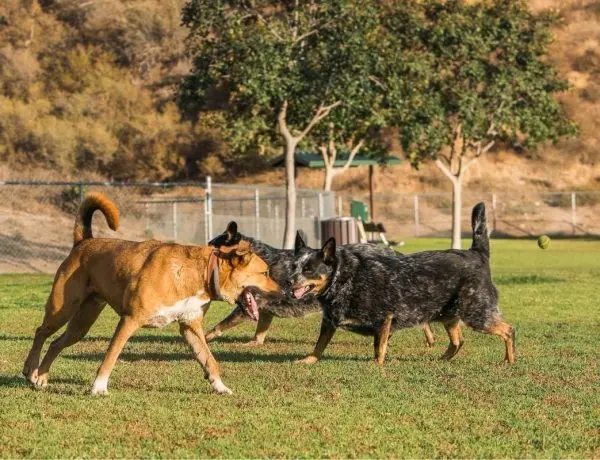The idea of adding a new puppy or adult dog to your home usually brings about thoughts of playing ball, enjoyable walks around the neighborhood, and cuddling on the couch. However, this lovely scenario is often interrupted when your new dog begins jumping on guests, nipping at fingers, or chewing on your favorite items. At that time, you might start considering some professional help and wonder if dog training classes are worth it.
While it may be possible to train your dog to be a calm and respectful family member on your own, it is often helpful and extremely beneficial to enroll in some type of organized dog obedience class. With a variety of training styles, scenarios, and prices available, you should be able to find a dog training class that is a perfect fit for your pooch!
To honestly answer the question of “are dog training classes worth it,” we need to explore a few things such as: what is actually taught in the class, the format of the class, and of course, the actual cost of the training. In this article, we will talk about the different training options available and the average price of each, and how to go about finding a trainer and class that is right for your dog.
Table of Contents
What Type of Dog Training Classes Are Available?
As a trainer, I tend to think of a basic group obedience class when someone asks about dog training classes. However, it was brought to my attention that “dog training classes” can also be a generic term for any professional trainer’s assistance. So, let’s look at some of the different types of training formats that are available and the situations they work best for.
Group Classes
Group classes usually consist of one trainer working with several dog and owner teams at the same time. The class size can vary from only 3 or 4 teams all the way up to large group classes of 15-20 teams, and there are benefits and drawbacks to each end of that scale. In a smaller group class, you will generally get more one-on-one attention from your trainer. This is a benefit, as it allows the trainer to get to know you and your dog better and customize the training better to suit your individual needs. In a smaller class (depending on the location), your dog will have less distraction to deal with than they would have in a class with many other teams participating. However, that small class size may actually be a drawback if you were hoping to expose your new puppy to many new people and dogs, or if you are hoping to prepare your dog to work in highly distracting environments in the future. Sometimes, the cost of a smaller class may be slightly higher than a large class as well.

Most trainers offer different levels of group classes in hopes of having dogs close to the same skill level, so they can teach the same things to each team. Carefully examining what the prerequisites are for each class, as well as what you can expect your dog to learn during the course, is crucial in deciding which one to enroll in.
If you have a young puppy, I recommend looking for a class geared explicitly toward puppies. While it may be distracting for your pup to learn around a bunch of other happy, wiggly pups, it will give them some much-needed exposure to other dogs. Having a class that is limited to young dogs often reduces the chances of your pup having a bad experience with another dog that may not be accustomed to puppy behaviors. On the other hand, if you have an adult dog, they might do better in a class of other adult dogs so you can begin working on basic commands right away rather than wasting time discussing housebreaking and puppy nipping if those things don’t apply to your situation.
In most parts of the country, you can expect to pay between $100 and $300 for a six-week group class, making group classes one of the most affordable training options. Group classes usually meet once per week for about an hour and are often held in a park, training facility, or pet store.
Most trainers will spend a portion of the class explaining a topic (either a behavior issue or a command) to the entire group and then offer you time to try the exercise with your own dog while they supervise and give suggestions. Depending on the class size, this can mean a lot of time spent listening and waiting for your turn, which frustrates some people (and dogs!). The classes are generally intended as mostly instruction time for you, and you will be expected to spend time each day working with your dog before the next session. If you do not do this homework, it is unlikely that you will see the results you hope for.
Private Training Sessions
If your work schedule does not allow for you to attend a weekly group class, or if your dog is aggressive around other dogs, perhaps private training sessions would be a better route for you! With private training sessions, you may have the option of going to a trainer’s facility, meeting in a park, or having the trainer come to your house to work with you and your dog.

To solve behavior problems that occur in the home, doing the training in your home is often the best choice. For instance, if your dog jumps up on the counter, it will be nearly impossible to work on that in a group class where there are likely no counters to jump up on.
In-home private sessions remove the distraction factor of other dogs and people. This can make it easier for a dog to learn new basic commands. However, you must eventually practice these new commands around distractions if you want your dog to respond in various settings.
If you are experiencing any sort of aggression issues with your dog, a group class is NOT the place to begin working on those issues, as it puts others at risk. A private training session is an option that you might want to consider if you need help working on aggression, whether that be aggression toward other dogs or toward people.
You can expect to pay more for private sessions than you would for a group class. Prices for private sessions vary significantly by the trainer but often run between $60 and $150 for a one-hour session. Some trainers will charge additional travel fees to come to your home as well.
Board and Train or Boot Camp
Another training option is to send your dog away to a trainer’s facility or home for training. While some trainers offer this type of training on a daily basis, most require you to leave your dog with them for a period of time, usually ranging from 2-4 weeks.
A board and train will allow your dog to be completely immersed in the training process. That will often speed up the learning process, as they will be surrounded by experienced people, and most distractions will be controlled. However, many boot camps are done in a training facility rather than a home setting, which may inhibit the ability to work on specific issues you could be experiencing in your home environment.
Sending your dog away for training can kick-start their learning, but if the training is not continued when returning home, the results will often fade. Any board and train option should include at least a couple of follow up lessons so the owner can see what was taught to the dog. More important than being shown the results, is for the owner to learn how to continue on with the training in the dog’s own environment.
Board and trains are usually much more expensive than the other two options we discussed. You can expect to pay at least $50 to $75 per day and often as much as $2500 for two weeks of training. While it is important to research which trainer you want to work with for any type of class, it is imperative that you carefully research the trainer and their facility if you are going to send your dog away for training.
Is Professional Training Really Necessary?
The answer to this question depends heavily on what you expect out of your dog, your dog’s age, and what behavior problems you might be experiencing. If you have adopted a young adult dog that is already well-socialized with people and other dogs, and you have had some success teaching your dog how to respond to commands, professional training may not be necessary. However, with a young puppy, a group class can be incredibly valuable, even if you are an experienced trainer!
Although I have been training dogs (and their people) for close to 25 years, I always enroll my own puppies in a basic group class taught by someone else when they are around 4 months old. While I might not feel that I need the instructor’s help with training techniques, I do feel that working in a group environment, with the distraction of other people and dogs, is necessary for my puppy’s development.
With careful planning and some creativity, it is possible to create the distraction of a group class on your own while training your dog. You could do training sessions at a park, so your dog learns to work around other people and dogs.
Many stores will also allow well-behaved pets in their stores, which can be an excellent place to perfect your dog’s training! However, please make sure your dog is friendly, well-behaved, and leashed before taking them into a store. Most pet owners know that their dogs are welcome at stores like PetSmart and Petco, but other stores such as Tractor Supply Co., Michaels, and Bed Bath & Beyond also welcome well-behaved dogs! There are several other stores that people have claimed to be dog friendly (including Lowe’s, Home Depot, and Barnes and Noble), but many of these stores do not have a company-wide policy, and instead, they leave the decision up to the individual store manager. Please be sure to contact the store to verify their pet policy before arriving with your dog.
Shopping with your dog can be fun and excellent training experience, but you may decide that it is easier to just sign up for a basic obedience class – or that you need that obedience class before your dog is ready to join you on your shopping trip!
If you are a new dog owner, it can be overwhelming to sift through all of the training books, articles, and videos available to you! While there is a lot of great information out there that will help you train your dog, there really is no substitute for an actual trainer that gets to know you and your dog. An experienced trainer is a valuable resource for determining which training techniques will work best for your particular dog! A good trainer spends equal (or more!) time training you so that you can guide your dog throughout their life.
Unfortunately, not every dog is naturally a friendly, well-behaved, good citizen. If you are experiencing behavior problems with your dog (especially any sort of aggression) or if the training techniques you have tried do not produce the results you want, hiring a professional to assist you might be necessary.
What Are Some Other Benefits of Dog Training Classes?
The obvious benefit of training classes is having access to an experienced, professional trainer to guide you and your dog to a healthy and happy relationship. But, there are other benefits to classes as well that you might not have thought about.
The first is that spending money on something often holds us more accountable. Although there are plenty of ways to exercise at home, many people spend money each month on a gym membership, knowing that spending that money will encourage them to actually go there and exercise. It’s the same with dog training! If you invest money in your dog’s training, you may be more likely to set aside time each day to train your dog, so that the money you spent is not wasted.
Besides the monetary investment holding you accountable, putting an appointment on your calendar – whether your weekly group class or an appointment with a private trainer – will often motivate owners to work with their dog more. Even as a professional trainer, this is the motivation that I need! Although I have the tools and knowledge to train dogs, I know that I often procrastinate when it comes to training my own dogs! I have found that knowing I’m going to be in a class with other people that have worked with their dogs all week motivates me to do the same, so my dog doesn’t fall behind in class. I hear the same thing from my private clients. I try to encourage them to schedule their next appointment with me as we finish up our lesson. That appointment tends to motivate them to do their homework much better than if they are given the option to call me later for their next lesson.

I have already covered the benefit of dog socialization that comes from dog training classes, but people socialization is also a benefit! It is nice to spend time with other people that feel the same way about their dog as you feel about yours! It is also enjoyable to go through a class with other people and their puppies, and it is fun to watch the other teams mature and reach their goals. It can also be very comforting to be around other people that might be experiencing the same issues with their dog as you are with yours. I have seen significant friendships develop in group classes between people that often last way beyond graduation day!
How Do I Find the Best Class for My Dog?
Hopefully, I’ve made it clear to you that I genuinely believe dog training classes are worth it! Now, the next step is finding the right trainer and class for your dog. This is not an easy task. The right class can be invaluable to your dog and your relationship with your dog. On the other hand, the wrong trainer or class can be a disaster, resulting in wasted money, or worse, more problems than you started with.
Ask For Referrals
Many trainers will happily offer you references to verify their competency and results. However, no trainer will send you to people who were unhappy with them, so these references are often biased. Rather than asking the trainer for references, ask other people to refer you to trainers they have worked with and been happy with.
Your veterinarian’s office is a great place to start! Many have a list of trainers who have either worked with themselves or learned about from their clients. And, if you see someone out and about with a well-behaved dog you admire, don’t be afraid to ask them if they worked with a trainer to get their dog to act that way.
Talk to the Trainer Personally
Websites and flyers can be a useful resource when you are researching trainers and dog classes. However, when you have narrowed your options down to a few that you might enjoy working with, make a phone call!
I strongly recommend an actual phone call whenever possible, as opposed to an email or a text. Ask questions of the trainer and listen carefully to their answers! Are they familiar with your breed of dog? Are they easy to understand, and are they able to explain their training methods well? You need a trainer that is able to train dogs, but they must also be able to teach people! And, their way of teaching needs to coincide with your style of learning to be a good match.
Unfortunately, the dog training industry does not have any official licensing in place. So basically, anyone can call themself a dog trainer and charge for their services. While there are organizations that offer certifications and memberships, some of those require nothing more than filling out a quick application and paying a fee for that certification. There are a few schools that offer classes for dog trainers, but even those are not really a substitution for actual experience.
Talk with your trainer and find out how long they have been training as well as what they have accomplished in that time (either titles they put on their own dogs, or accomplishments their students have made). You can certainly take certifications into account, but make sure to verify where they came from and what requirements were met to achieve them.
Ask to Observe a Class
Some trainers offer a free consultation. If this is an option, take advantage of it! But be careful of training companies that send out their sales staff to do these consultations rather than sending their actual trainers. If that is the case, you will often get a great sales pitch, yet still know nothing about the actual trainer you will be working with.
Don’t overlook a trainer that doesn’t offer free consultations – especially if that trainer offers in-home lessons. It is time-consuming and costly for them to schedule a home visit for free. However, that trainer should be willing to answer some basic questions for you over the phone about their training techniques and theories before scheduling a lesson that you will be required to pay for.
If the trainer you are considering offers group classes, ask if you can observe one of their classes without your dog. Most are happy to allow that! Watching a class will give you a chance to evaluate how they communicate with their students and the dogs, as well as give you some insight into their training methods. If you stay until the end of class, you might be able to speak with a couple of the students and get some feedback on their experiences.
How Much Do Dog Training Classes Cost?
When people ask if something is “worth it,” many times they actually mean “is it worth the amount of money spent.” When it comes to dog training, the cost can vary greatly. You will need to decide the value of the class based on what your expectations are. For example, if you have a basically well-behaved young adult dog that you just need a little help with teaching commands to, it might be a great value to take a six-week group class for $120 to get that help and socialization. In that particular case, a $2500 board and train option would not be a good value for you. However, for a severely aggressive dog, that may end up re-homed or even euthanized without proper training, that $2500 price tag could be an incredible value to the owner (and the dog as well!).
With many things in life, you often “get what you pay for.” However, I have found in dog training, that isn’t always the case! With some research, you could find an excellent class with experienced trainers at the low end of the price range. And, just because you are paying top dollar for your lessons, it doesn’t necessarily mean you are working with the most experienced and talented trainers.
As I said before, research before choosing someone to work with! Take the price into consideration, but more weight should be put on what you will actually get out of the training. An extremely cheap class that you learn nothing from is still wasted money.

For a basic group obedience class, you should plan on spending between $100 to $300 for six to eight classes. However, you may be able to find effective classes for a lower price tag if you check with your local obedience clubs, shelters, and humane societies.
Private lessons often carry a slightly higher price tag at between $60 and $150 per session. Some trainers vary their prices based on whether they go to your home or you come to their facility. Many also offer a reduced rate per session if you purchase a package of multiple sessions.
Board and train or boot camp training is the most expensive option, often running at least $50 to $75 per day or even $2500 for a two-week (or more) program. Many of these board and trains will include a private session when the training is complete, and some also include follow-up group classes for free or for a reduced price. Make sure to ask what is included before sending your dog! While that sounds like a high price tag, if you can do the board and train during a time that you would be boarding your dog anyway, it tends to sound much more affordable! A regular boarding kennel usually runs between $20 and $50 per day, and that does not include any training. So, if you have a trip planned and would like to come home to a better-trained dog, you might want to consider the board and train option even for basic training.
Final Thoughts
It is possible to end up with that perfect dog that never gets in any trouble and always does what you ask – but that is a rarity! Those “perfect dogs” are usually the result of clear and consistent training from their owner throughout their life.
If you are happy with your dog’s behavior as it is, or if you are successfully training your dog on your own, that is great! But if there are any parts of your dog’s training that you are struggling with, I strongly recommend exploring the dog training class options in your area. You may find out that your dog is capable of much more than you expected! At the very least, you’ll have an opportunity to spend some quality time with your dog and possibly meet some new friends both for you and your pup!




